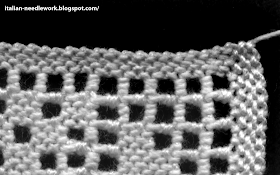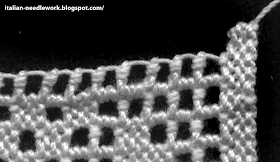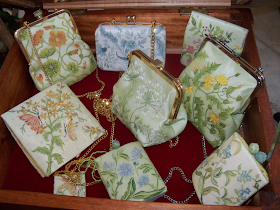Here is another article that I wrote for the old
Tuttoricamo website which will not be reappearing on
the new blog format.
The Royal Tiraz Workshops of Palermo, Italy historically produced some of the most sought-after and high-quality embroideries and textiles in the world.
“Ṭirāz - The word is borrowed from the Persian and originally means “embroidery”; it then comes to mean a robe adorned with elaborate embroidery, especially one ornamented with embroidered bands with writing upon them, worn by a ruler or person of high rank; finally it means the workshop in which such materials or robes are made.”
-- E.J. Brill’s First Encyclopaedia of Islam, 1913-1936 by M. Th Houtsma, Sir Thomas Arnold, 1987.
There are many references to the
Royal Tiraz Workshops of Palermo, Sicily which are credited with some of the richest embroideries in all of history.
Ernest Lefébure writes in his book, ‘
Embroidery and Lace: Their manufacture and History from the remotest antiquity to the present day’, 1888, that: “
The Saracens had already introduced into Sicily the art of weaving silken and golden fabrics, an industry subsequently encouraged by King Roger II.” In ‘Needlework, an illustrated history’ edited by Harriet Bridgeman, 1978 we are told that Roger II found that the Arab Tiraz workshops were “
...still active, he brought Byzantine weavers to train Sicilians but continued, it is thought, to use Arab embroiderers.” In ‘
Ricami Italiani Antichi e Moderni’
Elisa Ricci writes, “In Italy the great art of embroidery started around the year 1000 in Sicily during the rule of the Saracens”.
It can be argued that the Byzantines already occupied Sicily before the Saracens who were famous for their excellent embroideries. Before the Byzantines the ancient Greeks were there, also renowned for
their rich embroideries. Sicily had many conquerors and due to religious tolerance before the time of the
Inquisition, many different peoples co-existed on the island and it is probable that the best of all embroiderers, weavers and silk manufacturers culminated into what became a place that produced the crème de la crème of textile work under Norman Rule. Byzantines, Saracens, Greek-Orthodox, Roman-Catholic Christians and, it is thought, also Jews each gave the flavour of their individual cultures to produce some spectacular embroideries and art objects over the centuries. Works made in the
Royal Tiraz Workshops of Palermo reflect Byzantine, North African, Middle and Near East and Spanish art and with the adoption of using gold filigree, pearls and enamels, produced a new and unique style thus making them distinguishable from artifacts produced in the Tiraz workshops of other cities.
What all historians seem to agree on is that under the rule of the Norman King Roger II (reign: 1130 - 1154), the
Tiraz embroideries of Palermo were much sought after for both secular and ecclesiastic uses. European crusaders passing through Sicily on their way home from the east brought with them many richly embroidered robes and clothing. This caused a great demand for these items and consequently some were manufactured in Sicily and regarded as highly prized gifts.
Lefébure tells us that King Roger II had the most skilled weavers and embroiderers from Greece brought to Palermo between 1145 - 1147 where he set up workshops.
John Julius Norwich writes, “
It has sometimes been claimed that they (the women silk workers - most probably Jewish - taken from Thebes) were the nucleus around which the celebrated royal silk mills of Palermo were built up. This theory does them too much honour - though they may well have introduced new techniques. Ever since the time of the Omayyads it had been the practice, in all the principal Islamic kingdoms of the East and the West as well as in Constantinople itself, to maintain a silk workshop in or near the palace for the manufacture of robes and vestments for ceremonial court occasions. Sicily was no exception, and the Palermitan silk Arabs - from whose language the Tiraz, or royal workshop, took its name. Another long established Muslim custom, however, required the ladies of the Tiraz, when not at their looms, to render other, more intimate services to the gentlemen of the Court. This tradition too the Normans, eclectic as ever, had appropriated with enthusiasm; and it was not long before the Tiraz became a useful, if slightly transparent, cover for the royal harem.”
In any case, it was here that the kingdom’s silk industry was eventually controlled from start to finish, from the cultivation of the silkworm, to the spinning, weaving, dyeing, embroidering and assembly of the final products. Roger II’s court was culturally rich and prosperous and the textile art of Sicily was renowned throughout Europe.
During Roger II’s son William I’s reign (1154 - 1166), an agreement was reached between the Byzantine Empire and Sicily in which former Greek prisoners were to be returned home. Interesting to note that William returned all prisoners except the ladies of the
Tiraz. Later, revolts by the populace during the reign of William I resulted in the terrible loss of many artifacts of the
Tiraz kept in the palaces of Palermo, what was not carried off by looters was burned in huge bonfires.
Henry IV of Hohenstaufen not only ruled Sicily (1194 - 1197) but was also Holy Roman Emperor. He is reported to have taken the best remaining
Tiraz artifacts off to Germany and the 1246 inventory of the Trifels Castle records possession of the Tiraz-made Mantle of Roger II, thus supporting this theory. Visit
Racaire's blog for some great photos of this and other
Tiraz artifacts now held in the
Kunsthistorische Museum in
Vienna.
Frederick II (reign: 1198 - 1250) wore a different mantle produced in Palermo around 1200, decorated with the eagles of Swabia, now preserved in Metz, France according to Austrian researcher
Bettina Pferschy-Maleczek. The last ‘golden age’ of the
Palermo Tiraz is reportedly to have been at the beginning of the 13th century. After the death of his wife, Constance of Aragon, Frederick moved his court and silk makers to Foggia (Apuglia). Constance of Aragon was buried in Palermo and an excavation in the 18th century unearthed her embroidered crown, “... made of gold thread thickly studded with pearls and jewels—rough sapphires and carbuncles, among which may be noticed a red cornelian engraved in Arabic with this sentence, ‘In Christ, God, I put my hope.’”
Surviving written sources attest to almost 100 years of uninterrupted production from the
Tiraz of Palermo ranging in things from silk textiles and embroideries to gold-work, jewellery, ivory-work, woodwork and metalwork, other sources suggest a strong and exclusive tie between the royal workshops and a noble clientele.
Alexander of Telese and
Philagathos of Cerami, writers from the early 12th century, wrote of wall hangings, veils and the silk clothing of servants in Palermo.
Strangely, news of the
Tiraz artifacts are more easily found in writings during Roger II’s reign than during the later rule of Frederick II. The 18th century opening of the tombs of Roger II, Henry VI, Constance of Hauteville, Frederick II and his wife Constance of Aragon brought about the writing of detailed documentation on the textiles of the Hohenstaufen period.
Sicily would suffer decline under French rule and after the
Sicilian Vespers (1282) and the resulting war, many artisans, weavers and embroiderers fled north into Italy and the cities of
Lucca,
Venice,
Genoa and others. Evidence suggests however, that not all the embroiderers abandoned the island, but a few continued in some way; as the famous
Guicciardini Coverlets, worked in
Trapunto and commissioned by a wealthy Florentine family at the end of the 1300s have been identified as Sicilian work of professional quality. During this time Sicily was under Spanish rule and many
Tiraz workshops were operating in Almeria, Spain which were said to rival even the
Tiraz workshops of Bagdad so it seems plausible that the
Tiraz workshops of Sicily continued in some form, perhaps no longer as ‘royal workshops’. The city of
Messina was known for its silk production well into the 17th century.
 |
| Roger II's Mantle. Image from the article at Wikipedia. |
An official ending of the
Tiraz workshops of Palermo is presumed by the transference of the Royal Court of Frederick II to Apuglia and while E.J. Brill’s
First Encyclopaedia of Islam says that the
Tiraz workshops in Palermo produced woven silks until the 13th century; an article in Vol. 1, No. 5 of
The Brochure Series of Architectural Illustration cites the 16th century. There is undoubtably much further research to be done on this point.
The
Kunsthistorisches Museum in
Vienna, Austria holds a number of items produced at Palermo, among which are:
King Roger II’s Mantle which is dated 1133-1134 according to the embroidered Arabic inscription. It is the oldest surviving evidence of the
Tiraz in Palermo.
The Blue Dalmatic dates from the mid 12th century;
the Alb was made in Palermo in 1181 for King William II (reign: 1166 - 1189) and
his stockings; these pieces passed to Frederick II and the Alb was further embellished for his coronation as Holy Roman Emperor in 1220; there are also a pair of shoes and gloves and a few other items all richly embroidered in gold, pearls and jewels which are attributed to Sicily.
In 2004 the
Kunsthistorisches Museum exhibited it’s collection in an exhibition entitled:
NOBILES OFFICINAE, The Royal Workshops in Palermo during the Reigns of the Norman and Hohenstaufen Kings of Sicily in the 12th and 13th century. The event was organized with the
Soprintendenza per i Beni Culturali e Ambientali di Caltanissetta and was joined by a companion exhibition in Palermo at the Palazzo dei Normanni. Here is a
9 minute YouTube video presentation.
 |
| Palazzo dei Normanni, Palermo. Image taken from the article on the palazzo at Wikipedia. |
A catalogue of the exhibit (in German) is still available from the Kunsthistorisches museum store, there is also an Italian/English text of two volumes which can be found at used booksellers. It is indispensable as a reference on this particular subject. One of the results of these exhibitions was that textile fragments from Milan, Darmstadt, Paris and Brussels were brought together and identified as pieces from the
Tiraz of Palermo.
Photos of other examples of surviving embroidery attributed to Palermo can be found in
Paolo Peri’s book, ‘
Storia e Arte del Ricamo, Il Punto di Casalguidi’ (2007) which include an Altar-frontal, a Cope and the Funeral Cushion of St. Francis of Assisi. Recent carbon dating has confirmed that the Funeral Cushion of St. Francis is of the correct period and Mr. Peri hypothesizes is that it may have been donated by John of Brienne, King of Jerusalem (reign: 1210 - 1215) and Emperor of Constantinople (reign: 1229 - 1237), who had actually met St. Francis in Damietta between 1219 and 1220. (John of Brienne’s daughter Yolande married Frederick II Holy Roman Emperor, in 1225.)
Further Reading:
A Thousand Years in Sicily, by Giuseppe Quatriglio, 2005.
Embroidery and Lace: Their manufacture and history from the remotest antiquity to the present day, by Ernest Lefébure, 1888.
E.J. Brill’s First Encyclopaedia of Islam, 1913-1936 by M. Th Houtsma, Sir Thomas Arnold, 1987.
Needlework, an illustrated history, edited by Harriet Bridgeman, 1978 .
Nobiles Officinae: Perle, Filigrane E Trame Di Seta Dal Palazzo Reale Di Palermo, Vol. I & II, by Maria Andaloro, 2006.
Ricami Italiani Antichi e Moderni, by Elisa Ricci, 1925.
Sicily: Three Thousand Years of Human History, by Sandra Benjamin, 2006.
Storia e Arte del Ricamo Il Punto di Casalguidi, by Paolo Peri, 2007.
The Brochure Series of Architectural Illustration. Volume 01, No. 05, May 1895,
Two Florentine Pavements, BATES & GUILD, BOSTON, MASS.
The Normans in Sicily, by John Julius Norwich, 1992.
The Silk Industry of Renaissance Venice, by Luca Molà, 2000.
Travels with a Medieval Queen, by Mary Taylor Simeti, 2001.




















































